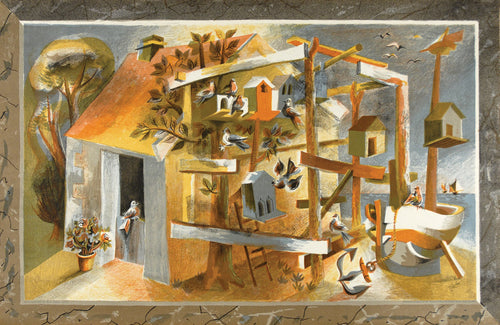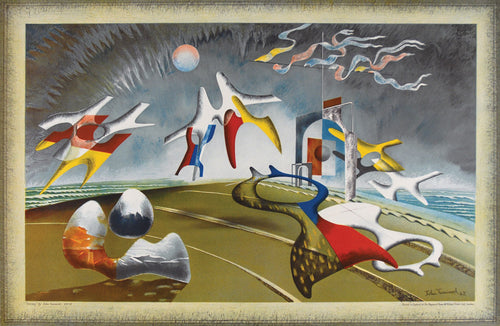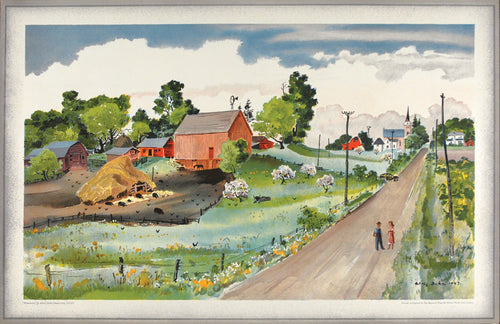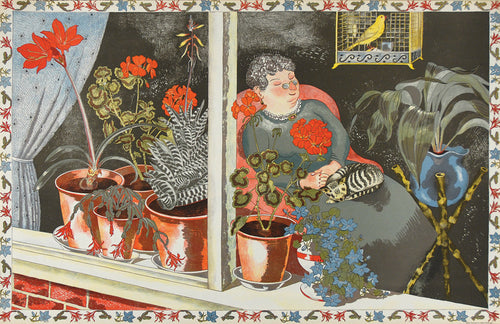
The story of the School Prints begins with Derek Rawnsley. Idealistic and adventurous, Derek was something of a renaissance man: an athletic pilot fresh from an illustrious Oxford career, where – legend has it – he had on one occasion flown from Australia to Abingdon in a secondhand Tiger Moth to avoid missing the start of term, breaking a world record in the process.

'Fisherman's Hut' - Hans Tisdall
In 1935 he set up the first iteration of the ‘School Prints Ltd’ business with a simple yet revolutionary idea: to bring quality reproduction prints of fine artworks to schools for hire, with the aim of introducing a world of art to young children who otherwise lacked the means or opportunity to visit galleries and museums themselves. Within two years he was operating out of an office in Bloomsbury, and had begun persuading schools to sign up to the scheme with a catalogue of almost 150 prints.

Newly weds Brenda and Derek Rawnsley
By 1939, the same year war broke out across Europe, Derek met Brenda, his future wife. They married in February of 1941, though their communion was to be tragically brief: on the eve of their wedding night, Derek was posted to Cairo as an RAF pilot. Brenda soon signed up with the Women’s Auxiliary Air Force in an attempt to join him, but the pair were variously stationed in different locations. In early 1943 he was killed in an aeroplane accident, leaving Brenda behind and his nascent undertaking in the hands of an assistant.

'Monkeys' - Hans Feibusch
Despite having no knowledge of art or business, little money and even less man-power, Brenda took on the School Prints scheme in commemoration of her husband’s aspirations, determined to uphold his cause. Her ambition was immense: unlike Derek, she would settle for no less than original prints, rather than reproductions, commissioned directly from the most important contemporary British and European artists; these would be sold, not hired, an astounding proposition that few primary schools of the time would have given consideration.

'The Fairground' - Barbara Jones
To aid in the project, Brenda sought out key figures in the art world to collaborate. Among a small number, she attracted the attention of Herbert Read, a renowned critic and champion of radical young artists pathing the way in modern British art. Together, they gathered an advisory panel drawn from the world of art education and child psychology, ensuring subject matter was both suitable and educational for primary age children. Collectively, the panel would select artists and choose appropriate images from submitted sketches. Their parameters, both in terms of quality and content of image, were strict; rejection rates were high while standards were stringently upheld.


(top) Michael Rothenstein's 'Timber Felling', the artist's first ever print; (bottom) 'Tractor' by Kenneth Rowntree
Commissioning letters sent to the artists whom the panel deemed suitable explained the project in further detail, requesting a small rough draft for them to consider. Brenda was advised on limitations for each print which would maximise their ease of production and presentation: no more than six colours were to be used in each composition, which must include an illustrated border so as to allow schools to display the works either mounted in a frame or pasted directly onto the classroom walls. In subject matter, the artists were given free rein: providing the image remained innocent, the desire that each print be representative of real, fine art indicative of the artist’s imaginative skill remained of paramount importance.
 One of the more artistically 'mature' School Prints, John Tunnard's 'Holiday'
One of the more artistically 'mature' School Prints, John Tunnard's 'Holiday'
Major obstacles continued to dog the project, most noticeably that of sourcing the labour and materials for so many prints (though the final edition size was never documented, the number almost certainly ran into the thousands). During the post-war period, resources such as paper sheets and cardboard were heavily rationed, forcing Brenda to navigate the hazy waters of the black market in a last-ditch attempt to collect enough supplies from whatever sources she could find.

'Town Centre' - Phyllis Ginger
Of the 24 prints eventually commissioned in two sets of 12, almost all were produced as auto-lithographs, meaning the design was drawn directly onto the stone block by the artist. From her very first involvement with the initiative, Brenda had been determined that the School Prints series would offer children the very best in original art while accommodating a necessarily large edition. Auto-lithography was as near a process to original painting or drawing as could be realised within such limits, with little to no intervention by assistant, technician or machine between the start and finish of the final image on the block. In composition and conception, the artist was entirely responsible, resulting in works that were highly individual and representative of each illustrator’s unique stylistic flavour.


(top) 'Window Plants' and (bottom) 'Harvesting', both by John Nash
In the last ten years the Goldmark Gallery has had the incredibly good fortune to have acquired some of the last caches of School Prints lithographs in public and private circulation. Given the purpose of the works and their treatment in their natural environment, where they were pinned, glued, taped and pasted like posters, often in direct sunlight and surrounded by less-than-careful children, extremely few have survived, and even fewer in mint condition such as those illustrated here. A select number have become iconic images of their time, and are still recognised by visitors to the gallery whose childhoods were spent growing up with them: John Nash’s homely Window Plants, or the beautiful, centrifugal motion of Harvesting, in which farmers chase rats round a stylised crop of uncut wheat; Julian Trevelyan’s Harbour, with its scratched abstract clouds, unshaven sailors and their black feline companion.

'Harbour' - Julian Trevelyan
Most sought-after of the lot, however, was L. S. Lowry’s Punch and Judy scene. The image is Lowry, through and through: the ordinary mass of people, all walks of life, gathered in a vignette of stark, simple colours. It is a print Lowry evidently felt fond of, and which, as he explains, was typical of his painterly outlook: I am a simple man and I use simple materials: ivory black, vermillion, Prussian blue, yellow ochre, flake white – and no medium.

'Punch and Judy' - L. S. Lowry
Lowry’s print has proved so popular, in fact, that in recent years it all but disappeared from the market, until another recent stroke of good luck befell the Goldmark Gallery once more when a pristine stash of Punch and Judy prints were discovered wrapped in perfect, mint condition. Given the great displacement of the School Prints after they were sold to schools and passed on amongst future generations, we suspect this must be one of the very last collections of this fantastic print still intact.

In today’s world of cut funding and sanitised education, future reimaginings of the School Prints venture seem woefully improbable. That the project proved as successful as it was, even during the liberal, socially-minded world of post-war Britain, was no doubt a surprise to Brenda and her team, though a testament too to her vision and her husband’s, and to the generosity of its contributors both financial and artistic. While an equivalent contemporary project may seem far off, we can still marvel at the work invested in this series of prints and the extraordinary visual feast it left behind.










